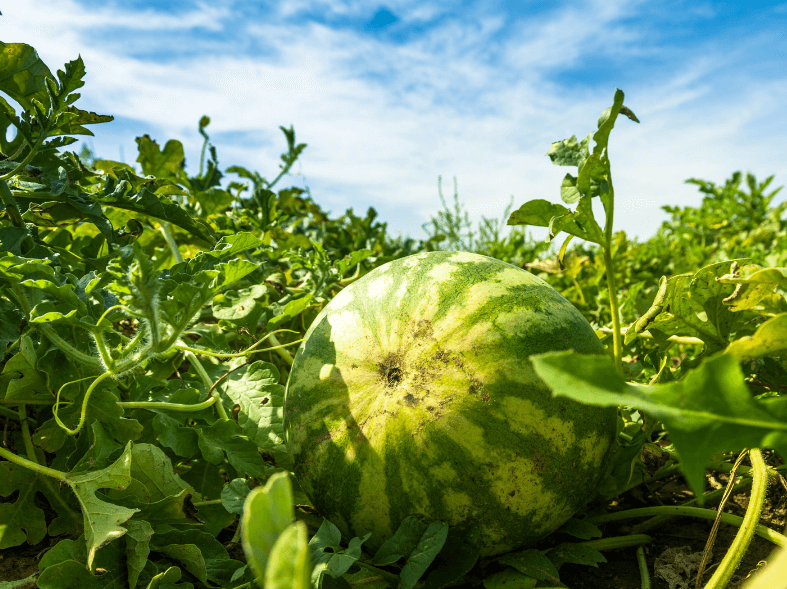This post may contain affiliate links. As an Amazon Associate we earn from qualifying purchases.
Hankering to learn how to grow watermelon? We’ve got you covered — read on!
What would summer be without watermelon? Oh, I know we can find it at the supermarket most of the year, often packed into one of those plastic clamshell containers and lacking flavour.
But I’m talking real watermelon. Fresh-from-the-garden (or at least fruit stand) watermelon.
Watermelon (Citrullus lanatus) is so ridiculously easy to grow. I started growing it at eight-years old and was quite successful, every year after. So, you got this.
And, by the way, if you have kids, it’s pretty much a sin to not grow watermelon. Just sayin’.
Where on earth did watermelon come from?
Did you know that there are 5,000-year-old Egyptian hieroglyphics depicting folks harvesting watermelon? Apparently, the first watermelons were pretty nasty.
“… but it was the Egyptians who began selectively breeding watermelon to achieve its palatable flavor,” claims Claire Mackman at Chapelboro.com.
The fruit became so popular that watermelon seeds were even found in the tomb of King Tut.
 Watermelon’s ideal growing conditions
Watermelon’s ideal growing conditions
Summertime and the livin’ is easy if you’re a watermelon. Provide your plants with an area of the garden that gets lots of sunshine (at least 8 to 10 hours a day), the soil is a bit on the sandy side and drains well.
For the most hassle-free growing, plan on throwing in some organic matter and mixing it well with the existing soil before planting the watermelon seeds.

Speaking of which
Get those seeds in the ground as after the last frost date in your area has passed. Don’t know what that is? The folks at Almanac.com do and they share with you on the website.
To be absolutely sure that you’re planting at the right time, check the soil temperature on a sunny day. If you don’t have a soil thermometer, use your instant-read meat thermometer from the kitchen, like this one:
If the soil’s temperature is 70 degrees Fahrenheit or more, you’re good to plant.
Gardeners in cooler climates typically start watermelon seeds indoors about three to four weeks before the last expected frost and transplant them outdoors once the soil warms up.
When planting watermelon seeds directly in the garden, space them about 6 feet apart in hills. Create small mounds of soil and plant three to four seeds per hill, about an inch deep. Thin the seedlings to the strongest one or two plants per hill once they have grown a few inches tall.
 Watering the watermelon
Watering the watermelon
Watermelons need consistent watering, especially during the early stages of growth and fruit development. Keep the soil evenly moist but not waterlogged.
Water at the base of the plants to avoid wetting the foliage, which can lead to disease. Mulching around the plants can help retain moisture and suppress weeds.
Fertilizing watermelon plants
Watermelons are heavy feeders and benefit from regular fertilization. The organic matter you added at planting provides a good nutrient base for the young plants. The first round of fertilization should occur when the plants have developed their first true leaves.
Those two leaves that pop out of the soil first? They’re called “cotyledon.” The leaves that sprout next are the “first true leaves.”
Use a balanced fertilizer, such as a 10-10-10 or 14-14-14 formula, and follow the manufacturer’s instructions for application rates.
Fertilize again when the vines begin to run and once more when the fruit sets. Be careful not to over-fertilize, as excessive nitrogen can lead to lush foliage but fewer fruits.

Pests to watch out for
Several pests can pose a threat to watermelon plants. Common pests include aphids, cucumber beetles, and squash bugs.
Aphids can be controlled with a strong jet of water from the house. Repeat in about three days and then once more three days after that for good measure.
Cucumber beetles and squash bugs can be managed by using row covers during the early growth stages and applying organic insecticides if necessary.
Another pest to be aware of is the vine borer, which can cause sudden wilting of the plant. Regularly inspect the base of the vines for signs of damage, and remove any affected plants to prevent the spread.

Diseases that affect watermelon
Watermelons can be susceptible to various diseases, including powdery mildew, downy mildew, and fusarium wilt. Powdery mildew appears as a white, powdery substance on the leaves and can be controlled by ensuring good air circulation around the plants and applying fungicides if needed.
Copper fungicide should do the trick and, yes, it’s ideal for organic gardening.
Downy mildew presents as yellow spots on the leaves, which eventually turn brown. Like powdery mildew, it can be managed with proper spacing and fungicide application.
Fusarium wilt causes wilting and yellowing of the leaves and is more challenging to control. Planting disease-resistant varieties and practicing crop rotation can help minimize the risk.
Harvesting your watermelon
Determining when to harvest watermelon can be tricky, but there are a few indicators to help you decide. The most reliable sign is the tendril nearest the fruit turning brown and drying up. The fruit should also have a uniform shape, a dull thud when tapped, and a creamy yellow spot on the underside where it rests on the ground.
Once harvested, allow the watermelon to sit at room temperature for a few days to develop its full flavor. Store it in the refrigerator to keep it fresh and enjoy it chilled on a hot summer day.
 Is watermelon toxic to pets?
Is watermelon toxic to pets?
Watermelon is not toxic to pets, making it a safe addition to gardens where pets may roam. In fact, many pets, especially dogs, enjoy eating watermelon as a treat. However, always remove the seeds and rind before offering it to your pets, as these parts can cause digestive issues.







